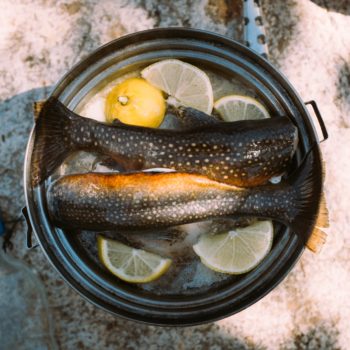What Are Ketones And Why Do I Want To Make Them?
Keto is a big buzz word right now, and it’s usually attached to a story about weight loss and regained health. Ketosis, or “keto” for short, is a way of eating that involves cutting out the vast majority of carbohydrates, and instead focuses on high-quality protein and fats.
In an average diet, there are many carbohydrate-based foods such as breads, pastas, rice, fruits, sodas, and other sweet or starchy items. They fuel the body with glucose, which is regulated in the bloodstream by a hormone called insulin. We all need insulin and glucose in some amount, but the majority of us could benefit from a reduction in both. Since insulin shuffles excess glucose into adipose tissue to be stored as fat, reducing both our glucose and our insulin can lead to a far easier time in losing excess fat. (1)
If you’re not eating carbohydrates, then how do you get fuel for your body? Fats! Instead of using carbs for energy, the body is able to burn fats instead, and it can be an even more efficient process.
This secondary fuel metabolism is called ketosis. When there are no more carbohydrates to burn for energy, your body taps into fats that are present either in your foods or already stored on your body. As these fatty acids are released, they are converted in the liver to ketone bodies, also called ketones, and these are the units of energy that your body will burn instead. This is where the term ketosis comes from. (2)
Ketosis has a long list of health benefits. Some of these are:
- A significantly easier time losing weight – Most people who try keto are aiming to get into better shape, and reducing carbs to a ketogenic level can make that a lot easier. Keto can help you choose more nutrient-dense foods, and naturally helps to reduce appetite. (3)
- Tighter blood sugar control – This is a way of eating that is ideal for someone who has pre-diabetes or other metabolic damage who wants to get healthier. Since carbohydrates aren’t present to constantly create a blood sugar roller coaster, you can heal your metabolism and enjoy better energy throughout the day. (4)
- Sharper thinking – Even if you’re already in great shape, keto can help your mind to focus and your memory to improve. Ketones can fuel up to 70% of the energy needs of your brain, and can help you think faster and more creatively, since this fuel is more easily used. (5)
- Improved blood lipids – Decreasing carbs and increasing fats may run counter to what most doctors recommend, but it’s been proven that ketogenic diets can improve cholesterol levels. There is an adjustment period of a few weeks, or even a few months in those who are severely overweight, but after this adjustment, those on a keto diet can enjoy a healthier balance of cholesterol. (6)
If you can’t eat carbs, what can you eat? At first, it’s difficult to see past all the things that you can’t eat on a ketogenic plan. Instead, try focusing on the healthy, nutrient dense, delicious foods that you CAN eat!
Proteins like fish, beef, pork, chicken, and other meats are high on the list. Protein is essential to maintain muscle mass, and is especially important if you’re also working out. You don’t even have to choose the leanest cuts, since fats are allowed on this diet. Chicken thighs and fatty fish are popular.
Filling up on veggies is a great idea, and necessary to get enough vitamins and minerals. Green leafy vegetables are first on the list, followed by other non-starchy vegetables like zucchini, squashes, celery, cucumbers, mushrooms, etc. Root veggies like carrots or potatoes have too much starch, so avoid these, and watch the quantity of sugar in veggies like tomatoes and carrots.
Occasionally a little low sugar fruit is OK to get an antioxidant boost with a pop of just enough sweetness, and dark or brightly colored berries are perfect for this.
The ideal is to eat less than 20 grams of NET carbohydrates per day. Net carbs subtract the fiber in foods, since you can’t digest fiber. This means you’re only counting the sugar/starch content. Food labels will always tell you the total carbs in a food, as well as the grams of fiber. Some will have done the math for you, and in other cases, you’ll just have to subtract the fiber from the total, and that will give you the net carbs.
As a guideline, you want to stick to around 30% of your calories from protein, 60% of your calories from fats, and 10% or less of your calories from carbohydrates. Aim to eat 0.8-1.0 grams of protein per pound of lean mass you have on your body per day, and fill in the rest with healthy fats. You can use this calculator to give you even more accurate intake goals
For foods without labels, which are preferred since they are in a more unprocessed, natural state, use a food tracker like Cronometer or Lose It! to track your carb intake as well as your overall calorie intake. When you have been keto for a while, you can tweak your fat and protein ratios for more specific results, but when you’re getting started, it’s most important to track carbs and calories.
Make sure to drink plenty of water on a ketogenic diet. Your body holds on to less water when you’re in ketosis, so you may need to drink a little extra. Water is hydrating, helps flush toxins from the body, and helps in fat loss, so drink up! Take an extra glass each time you take your ketone product.
A ketogenic diet is one of the healthiest ways of eating you can choose, whether it’s for weight loss or for the other benefits that you can enjoy. There are a wide variety of foods that you can make yourself or choose from your favorite restaurants, and once you get started, it’s exciting to see results quickly.



